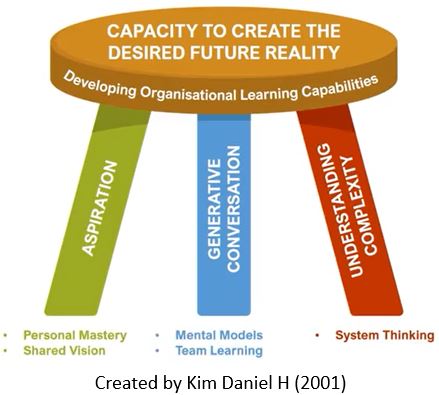Three-Legged Stool


The stool represents the interdependence of three core capabilities to support organisational learning (Aspiration, Generative Conversation and Understanding Complexity) that will help an organisation build the capacity to create the future or results it truly desires. The core of learning organisation work is based on the five “Learning Disciplines“
Aspiration Capability The Aspiration Capability focuses on developing a clear sense of purpose and shared vision at both the individual and organisational levels. The Capability includes the OL disciplines of Personal Mastery and Shared Vision. The discipline of Personal Mastery is about having the Capacity to articulate personal visions, comparing with current reality and moving towards a personal vision. The discipline of Shared Vision is about building a shared picture of a future SAF that everyone cares about creating together.
Generative Conversation Capability The Generative Conversation Capability is centred on expanding the SAF Leaders’ Capacity to be more reflective in their thinking and becoming more generative-oriented. The Capability includes the OL disciplines of Mental Models and Team Learning. The discipline of Mental Models helps the SAF Leaders be aware of underlying assumptions in becoming more reflective and conscious about perceiving the world and taking actions. The discipline of Team Learning requires the SAF Leaders to see how certain habitual patterns of interacting with others prevent them from learning to design strategies that can enhance a team’s ability to produce extraordinary performance for the organisation.
Understanding Complexity Capability The Understanding Complexity Capability emphasises internalising perspectives and skills that allow the SAF Leaders to better understand and manage the systemic interconnections that produce complex organisational dynamics. The Capability includes the OL discipline of Systems Thinking that provides a language and a set of tools for making the complex dynamic relationships of a system more explicit so that the SAF Leaders can identify the high leverage points for taking action.